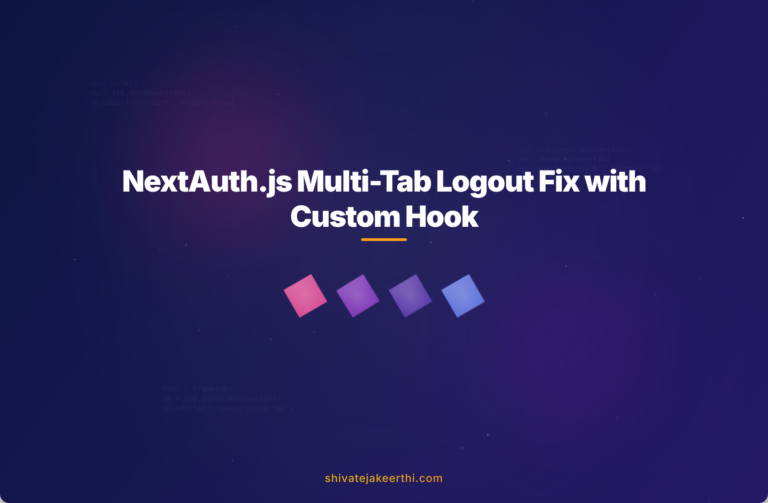If you’ve implemented authentication in your Next.js application, you’ve probably explored NextAuth.js. NextAuth.js is a popular, easy-to-use authentication library for Next.js apps, providing out-of-the-box session management and secure login/logout functionality.
However, a commonly faced issue with NextAuth.js is its session state lingering across multiple tabs. Imagine you’re developing a dashboard, and your users prefer multi-tab browsing. They log out from one tab expecting to be fully logged out everywhere—but find they’re still logged in when they return to other open tabs. Let’s unravel why this happens and how to effectively fix this issue.
Why Does NextAuth.js Logout Not Clear Session Across Multiple Tabs?
By default, NextAuth.js manages sessions via cookies coupled with client-side session state. When you log out using NextAuth’s built-in signOut() method, it invalidates and clears the session cookie in the current tab, but doesn’t automatically inform other tabs that the session has changed. Hence, other tabs are unaware of the logout event and continue displaying authorized UI elements.
This issue leads to some frustrating scenarios:
- You’ve got several browser tabs open for your app. Logging out from one tab doesn’t reflect immediately in the others.
- Other tabs require manual refresh to recognize the updated session state.
- If a new tab is opened after a successful login, the user is automatically authenticated, even if logged out elsewhere earlier.
- In a single tab, logout is flawless—but across tabs, it fails to maintain consistency.
Implementing Logout with NextAuth’s signOut()
When using NextAuth.js, logout functionality is typically done via the signOut() method from next-auth/react. Here is a common logout button example:
import { signOut } from 'next-auth/react';
export default function LogoutButton() {
return (
<button onClick={() => signOut()}>Logout</button>
);
}
This simple solution is great for single-tab use. But to handle multiple tabs effectively, you’ll need additional handling to sync session states between tabs.
Using a Custom Hook to Fix Logout Across Multiple Tabs
A popular solution to address NextAuth.js multi-tab logout is by leveraging browser storage events. Specifically, using localStorage events to propagate logout actions across tabs is practical and efficient.
Below is a straightforward custom React hook, useMultiTabLogout, that syncs logout between browser tabs effectively.
Creating the useMultiTabLogout Hook
Here’s the hook implementation:
import { useEffect } from 'react';
import { signOut, useSession } from 'next-auth/react';
export function useMultiTabLogout() {
const { data: session } = useSession();
useEffect(() => {
function syncLogout(event) {
if (event.key === 'logout') {
signOut({ redirect: false });
}
}
window.addEventListener('storage', syncLogout);
return () => window.removeEventListener('storage', syncLogout);
}, []);
useEffect(() => {
if (!session) {
localStorage.setItem('logout', Date.now());
}
}, [session]);
}
How Does it Work?
- When a user logs out in one tab, the
sessionobject becomes null, triggering the hook. - The hook sets a key (
logout) in localStorage with a timestamp. - Other tabs listening to the
storageevent detect the change in localStorage. - Once detected, other tabs automatically trigger logout through NextAuth’s
signOut({ redirect: false })method.
This setup ensures that logging out from one tab instantly reflects in all other tabs without manual refresh, providing a seamless user experience.
Step-by-Step Implementation Guide for Multi-Tab Logout in NextAuth.js
Follow these practical steps to quickly address the logout synchronization problem in your Next.js app using NextAuth.js:
- Create a new custom hook file, e.g.
useMultiTabLogout.js, using the provided snippet above. - Import this hook in your main layout or authenticated component that wraps your authenticated pages.
- Add this hook (
useMultiTabLogout()) directly inside your top-level authenticated component or layout. - Test it by logging out in one tab and checking if all other opened tabs become logged out automatically.
Testing the Fix Across Tabs
Testing is crucial to ensure your solution works reliably across various scenarios. Here is a simple testing approach:
- Open your application in multiple browser tabs while logged in.
- Log out from one tab using your logout button.
- Observe if other tabs instantly reflect the logout state without requiring manual refresh.
This simple test ensures the synchronization of logout status works perfectly. Consider various browsers you typically support to ensure compatibility.
Ensuring Session Security in Multi-Tab Environments
While resolving this issue might seem purely about user experience, it significantly impacts the security of your app. Users logging out expect the session cleared completely from their device. Unnoticed logins in other tabs can inadvertently expose user data to unauthorized users, particularly on shared or public devices.
By implementing this multi-tab synchronization solution for NextAuth.js, you’re enhancing both the usability and security of your application.
If you’re interested in more JavaScript and React tips, consider exploring more at our JavaScript articles page for detailed insights and practical guides.
Wondering if there are any other elegant solutions or facing any hurdles during implementation? Share your experience or leave your queries in the comments below. Let’s build secure, intuitive, and responsive Next.js apps together!



0 Comments